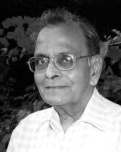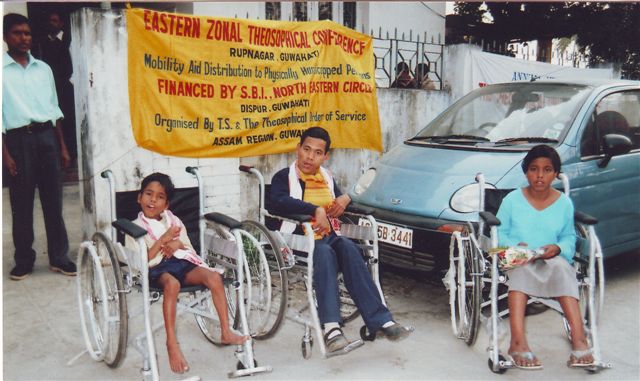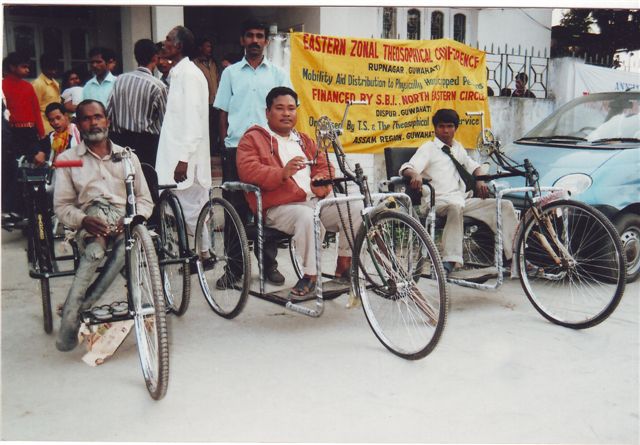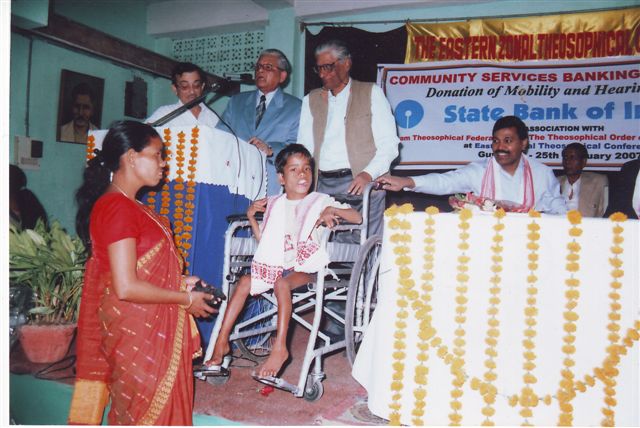 Can We Do Anything About This?
Can We Do Anything About This?
Mobility aids in India
Extracts from a talk given at the first international conference of the TOS on the subject of mobility aids in his country.
P.S. Mital National Secretary, TOS India
The sight of a sick man, an old man and a funeral moved Gautama Buddha to renounce his throne, to abandon all his royal comforts and family and to seek for humanity the path that would end sorrow. Daily, however, we see men, women and children in worse condition than some of what the Buddha saw yet we are not moved to action. Can there be worse misery than persons on all fours; persons dependent upon others even for such needs as hygiene, dressing and eating; persons wanting to go somewhere but looking for someone to take them there?
 One may ask, can we really do something? Yes, we can. There are many types of mobility aids that can make many of the disabled mobile to some extent. Here is a list:
One may ask, can we really do something? Yes, we can. There are many types of mobility aids that can make many of the disabled mobile to some extent. Here is a list:
-
The simplest aid, one that costs nothing, is ourselves. We can bodily lift, support and move the disabled as needed.
-
A cane or walking stick. For better stability nowadays, walking sticks with three and four legs are available.
-
Crutches. This is one of the cheapest devices we can donate. Many handicapped people can’t afford them.
-
A walker. Three years ago, at Anand Lodge of the TS in Allahabad, we distributed mobility aids to a number of handicapped people. A three-year-old boy who had always been in a lap and had never walked, was provided with a walker. The moment he started walking, the thrill was visible on his glowing face. Observing this expression of happiness was a blessing bestowed upon us that day. The little boy was so enthusiastic that he quickly crossed the threshold of the building, left through the main gate and went into the street! Fortunately a security guard saw him and brought him back.
-
A wheelchair. Prices vary with the degree of sophistication.
-
A self-driven wheelchair. These have large wheels on either side by which people can use their hands to drive the chair.
-
Battery-driven wheel chairs. These relieve the physical strain on the handicapped.
-
I recently saw on television a wheel chair provided with robotics which could even climb stairs.
-
A hand-propelled tricycle. These are three-wheeled vehicles with cranking handles on both sides that drive the wheels, through sprocket and chain. There is a front wheel device that permits turning left or right. In India these are by far the most sought-after aids as they enable their owners to pursue a living. They can be provided with a box for, say, newspapers or other articles to sell.
-
So far we have listed general mobility aids. There are, however, other devices made to measure as recommended by an orthopedic surgeon. One of these is calipers. A growing child needs frequent replacements, hence most people do not choose to donate these. However, in October 2004 we provided calipers to 10 children in Varanasi. Artificial legs are another made-to-measure device.
 Now let us see the extent of neurological and orthopedic physical disability in India. A survey has indicated that there are about four million people out of a population of one billion who need mobility aids. The most common cause is polio. An income of US$1 per person per day is the international poverty line and 50% of Indians fall below this line! 70% of children do not have access to adequate sanitation. Countless families with a handicapped child cannot afford even the simplest mobility aids, a situation that affluent nations would consider scandalous for their children. For the last seven years, the TOS in India has therefore retained mobility aids as its national service project. The regions in toto are given around 70,000 rupees per year [a little over US$1500] from the interest on its National Project Endowment Fund. The regions themselves also manage to collect almost the same amount in donations.
Now let us see the extent of neurological and orthopedic physical disability in India. A survey has indicated that there are about four million people out of a population of one billion who need mobility aids. The most common cause is polio. An income of US$1 per person per day is the international poverty line and 50% of Indians fall below this line! 70% of children do not have access to adequate sanitation. Countless families with a handicapped child cannot afford even the simplest mobility aids, a situation that affluent nations would consider scandalous for their children. For the last seven years, the TOS in India has therefore retained mobility aids as its national service project. The regions in toto are given around 70,000 rupees per year [a little over US$1500] from the interest on its National Project Endowment Fund. The regions themselves also manage to collect almost the same amount in donations.
 The sophisticated, designed- to-measure mobility aids mentioned above are very costly and effectively reserved for the rich disabled. The TOS concentrates on serving the poor. It collaborates with manufacturers receiving government aid but whose waiting lists are always long. When we provide money, the queue moves forward a little more quickly.
The sophisticated, designed- to-measure mobility aids mentioned above are very costly and effectively reserved for the rich disabled. The TOS concentrates on serving the poor. It collaborates with manufacturers receiving government aid but whose waiting lists are always long. When we provide money, the queue moves forward a little more quickly.
Dr J.B. Bannerji, an orthopedic surgeon in Allahabad who has devoted his whole life to the service of the handicapped, affirms that what is needed in India are mobility aids that can be manufactured in villages themselves, which will make them very cheap. He has developed a large number of aids using bamboo and other local materials. He says that bamboo is not at all costly, is very light, flexible and strong. I hope that the TOS will cooperate with him in his scheme.
It is often said that we should undertake big projects. What is important, however, is having the compassion and the helping spirit, and to do whatever we can, whether it be big or small. If we are not in a position to provide a wheel chair or tricycle or artificial leg, let us not hesitate to provide crutches, walkers or canes.
